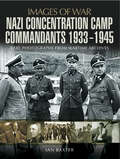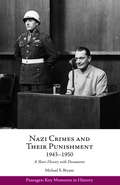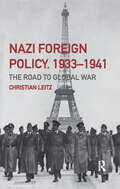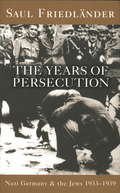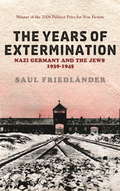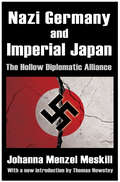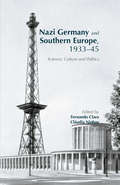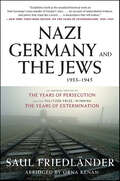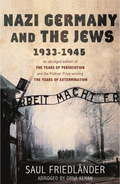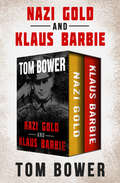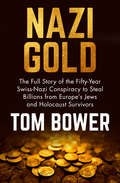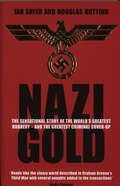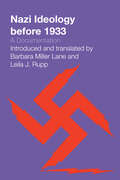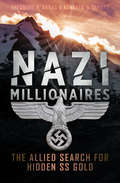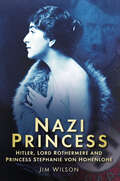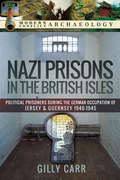- Table View
- List View
Navy's Needs In Space For Providing Future Capabilities
by National Research Council of the National AcademiesThe United States must operate successfully in space to help assure its security and economic well being. The Department of the Navy is a major user of space capabilities, although those capabilities are now primarily provided by DOD, the Air Force, and NOAA. Following a DOD assessment of national space security management in 2001, the Navy commissioned a Panel to Review Space to assess Navy space policy and strategy. As an extension of that review, the NRC was requested by the Navy to examine its needs in space for providing future operational and technical capabilities. This report presents a discussion of the strategic framework of future space needs, the roles and responsibilities for meeting those needs, an assessment of Navy support to space mission areas, and a proposed vision for fulfilling Naval forces space needs.
Nazi Billionaires: The Dark History of Germany's Wealthiest Dynasties
by David de Jong“A provocative group portrait of five industrialists who expanded their fortunes by colluding with Hitler and then, after World War II, walked away with minimal punishment and barely a dent in their bottom lines... In this meticulously researched book, Mr. de Jong, an investigative journalist and former reporter at Bloomberg News, compels us to confront the current-day legacy of these Nazi ties."—The Wall Street JournalA groundbreaking investigation of how the Nazis helped German tycoons make billions off the horrors of the Third Reich and World War II—and how America allowed them to get away with it.In 1946, Günther Quandt—patriarch of Germany’s most iconic industrial empire, a dynasty that today controls BMW—was arrested for suspected Nazi collaboration. Quandt claimed that he had been forced to join the party by his archrival, propaganda minister Joseph Goebbels, and the courts acquitted him. But Quandt lied. And his heirs, and those of other Nazi billionaires, have only grown wealthier in the generations since, while their reckoning with this dark past remains incomplete at best. Many of them continue to control swaths of the world economy, owning iconic brands whose products blanket the globe. The brutal legacy of the dynasties that dominated Daimler-Benz, cofounded Allianz, and still control Porsche, Volkswagen, and BMW has remained hidden in plain sight—until now.In this landmark work of investigative journalism, David de Jong reveals the true story of how Germany’s wealthiest business dynasties amassed untold money and power by abetting the atrocities of the Third Reich. Using a wealth of untapped sources, de Jong shows how these tycoons seized Jewish businesses, procured slave laborers, and ramped up weapons production to equip Hitler’s army as Europe burned around them. Most shocking of all, de Jong exposes how America’s political expediency enabled these billionaires to get away with their crimes, covering up a bloodstain that defiles the German and global economy to this day.
Nazi Concentration Camp Commandants, 1933–1945: Rare Photographs From Wartime Archives (Images of War)
by Ian BaxterUsing many rare and unpublished images this book identifies and delves into the characters of the notorious men who were instrumental in one of the greatest crimes against humanity in World history.Through words and pictures the chilling truth emerges. In many respects these monsters were all too normal. Rudolf Hess, the Commandant of Auschwitz, was a family man and hospitable host and yet while there is no record of his committing acts of violence personally he presided over a regime that accounted for over a million deaths. Others such as Amon Goeth and Josef Kramer personally promoted violence and terror and took pleasure from ever more brutal practices. They were competitive in obtaining 'results'. While following orders from above they did not hesitate to use their own initiative in pursuit of their barbaric objectives.Every occupied country in Europe was touched by the 'Final Solution' and despite the capture, trials and punishment of these leading perpetrators the stain of man's inhumanity to man, woman and child remains ineradicable.Justice came too late for millions but the lessons learnt must never be forgotten and this book throws new light on the managers of the murderous Holocaust process.
Nazi Crimes and Their Punishment, 1943-1950: A Short History with Documents (Passages: Key Moments in History)
by Michael S. Bryant&“With this timely book in Hackett Publishing's Passages series, Michael Bryant presents a wide-ranging survey of the trials of Nazi war criminals in the wartime and immediate postwar period. Introduced by an extensive historical survey putting these proceedings into their international context, this volume makes the case, central to Hackett's collection for undergraduate courses, that these events constituted a 'key moment' that has influenced the course of history. Appended to Bryant's analysis is a substantial section of primary sources that should stimulate student discussion and raise questions that are pertinent to warfare and human rights abuses today.&” —Michael R. Marrus, Chancellor Rose and Ray Wolfe Professor Emeritus of Holocaust Studies at the University of Toronto
Nazi Foreign Policy, 1933-1941: The Road to Global War
by Christian LeitzHow did the Second World War come about? Nazi Foreign Policy, 1933-1941 provides lucid answers to this complex question. Focusing on the different regions of Nazi policy such as Italy, France and Britain, Christian Leitz explores the diplomatic and political developments that led to the outbreak of war in 1939 and its transformation into a global conflict in 1941.Nazi Foreign Policy, 1933-1941 details the history of Nazi Germany's foreign policy from Hitler's inauguration as Reich Chancellor to the declaration of war by America in 1941. Christian Leitz gives equal weight to the attitude and actions of the Nazi regime and the perspectives and reactions of the world both before and during the war.
Nazi Germany (Idiot's Guides)
by Alan Axelrod Robert Smith ThompsonUnderstand the rise of a dangerous ideology.There is renewed interest in the Nazi Party that ruled Germany as a fascist state from 1933 to 1945 under the leadership of Adolf Hitler. However, the events that led to the rise of Nazism--and the near victory of the Axis Powers in World War II--date back to the economics and politics of 1860s Europe.From facts about the iron-fisted rulers who forged a new German empire to clear analysis of the Third Reich's psychological, political, and military underpinnings, learn all there is to know about the rise and fall of Hitler's Nazi Germany, including:The unification of Germany and the formation of the first empire under Prussian chancellor Otto von BismarckHow the Versailles Treaty's disarmament of Germany after World War I failed to ensure peaceAdolf Hitler's evolution from an imprisoned revolutionary to Nazi dictatorThe Nazi reign over Germany and occupied countries--including the military strategies of World War IIThe German military officers who plotted to assassinate HitlerThe justifications behind the Nuremberg trials
Nazi Germany And The Jews: 1933-1939
by Prof Saul FriedlanderA magisterial history of the Jews in Nazi Germany and the regime's policies towards them in the years prior to World War II and the Holocaust. Written by arguably the world's leading scholar on the subject.Himself a survivor, Friedlander has been a leading figure in Holocaust studies for decades and this book represents a definitive summing up of his research and that of hundreds of other historians. NAZI GERMANY AND THE JEWS: THE YEARS OF PERSECUTION is perhaps the richest examination of the subject yet written, and, crucially, one that never loses sight of the experiences of individuals in its discussion of Nazi politics and the terrible statistics and technological and administrative sophistication of the Final Solution.
Nazi Germany And the Jews: 1939-1945
by Prof Saul FriedlanderThe second and concluding volume of the definitive two-volume account of the HolocaustWith THE YEARS OF EXTERMINATION, Friedlander completes his work on Nazi Germany and the Jews. The book describes and interprets the history of the persecution and murder of the Jews throughout occupied Europe. The implementation of German extermination policies and measures depended on the submissiveness of political authorities, the assistance of local police forces and the passivity or co-operation of the populations, primarily of their political and spiritual elites. The implementation also depended on the readiness of the victimes to submit to orders, often with the hope of modifying them or surviving long enough to escape the German vice.This multifaceted representation - at all levels and in all different places - enhances the perception of the magnitude, complexity and interrelatedness of the multiple components of this history. Based on a vast variety of documents and an overwhelming choir of voices, Friedlander manages to avoid domesticating the memory of unparalleled and horrific events. The convergence of these various aspects gives THE YEARS OF EXTERMINATION its unique aulity. In this work the history of the Holocaust has found its definitive representation.
Nazi Germany and Imperial Japan: The Hollow Diplomatic Alliance
by Ian A. McLarenAlliances between sovereign states are among the least stable political associations. Despite professions of fidelity and common purpose, most are effective for only short periods, and only as long as it suits their interests. The German-Japanese alliance of World War II was not so much a marriage of convenience as a long and uneasy engagement. It was maintained because breaking the engagement would have reduced the prestige of each nation-state.Germany and Japan each found the existence and policies of the other convenient. From 1933-1945, both powers challenged the international order; other than this, nothing else united Germany and Japan. Even while they shared some of the same opponents, German and Japanese antagonism toward the Allies involved different objects of contention and questions of timing. Consequently, coordination of German and Japanese policies did not follow.Johanna Menzel Meskill argues that the German-Japanese alliance failed, not only because each power failed separately to attain its goals, but because as allies the powers failed to take advantage of their association. The failure resulted to a large extent from the discordance between their political goals and the means necessary to attain them. This work in diplomatic history is a careful analysis of presuming identities in a world of diplomatic differences.In a new introduction to the book, Thomas Nowotny looks back on the alliance from a historical perspective. He concludes that both parties overestimated the potency and effectiveness of their military power. Like many before and some after, they more generally subscribed to the offensive use of military power and effectiveness that the history of the twentieth centery has proven unwarranted.
Nazi Germany and Southern Europe, 1933-45: Science, Culture and Politics
by Fernando Clara Cláudia Ninhos Sasha GrishinNazi Germany and Southern Europe, 1933-45 is about transnational fascist discourse. It addresses the cultural and scientific links between Nazi Germany and Southern Europe focusing on a hybrid international environment and an intricate set of objects that include individual, social, cultural or scientific networks and events.
Nazi Germany and the Jews, 1933–1945: Abridged Edition
by Saul Friedländer Orna KenanNazi Germany and the Jews, 1933-1945 is an abridged edition of Saul Friedländer's definitive Pulitzer Prize-winning two-volume history of the Holocaust: Nazi Germany and the Jews: The Years of Persecution, 1933-1939 and The Years of Extermination: Nazi Germany and the Jews, 1939-1945.The book's first part, dealing with the National Socialist campaign of oppression, restores the voices of Jews who were engulfed in an increasingly horrifying reality following the Nazi accession to power. Friedländer also provides the accounts of the persecutors themselves—and, perhaps most telling of all, the testimonies of ordinary German citizens who, in general, stood silent and unmoved by the increasing waves of segregation, humiliation, impoverishment, and violence. The second part covers the German extermination policies that resulted in the murder of six million European Jews—an official program that depended upon the cooperation of local authorities and police departments, the passivity of the populations, and the willingness of the victims to submit in desperate hope of surviving long enough to escape the German vise.A monumental, multifaceted study now contained in a single volume, Saul Friedländer's Nazi Germany and the Jews, 1933-1945 is an essential study of a dark and complex history.
Nazi Germany and the Jews: 1933-1945
by Prof Saul FriedlanderAn abridged edition of Saul Friedlander's definitive two-volume history of the Holocaust: THE YEARS OF PERSECUTION and THE YEARS OF EXTERMINATION.Saul Friedlander's historical masterpiece is perhaps the richest examination of the Holocaust yet written, and, crucially, one that never loses sight of the experiences of individuals in its discussion of Nazi politics and the terrible statistics and technological and administrative sophistication of the Final Solution.The book's first part, dealing with the National Socialist campaign of oppression, restores the voices of Jews who were engulfed in an increasingly horrifying reality following the Nazi accession to power. Friedländer also provides the accounts of the persecutors themselves - and, perhaps most telling of all, the testimonies of ordinary German citizens. The second part covers the German extermination policies that resulted in the murder of six million European Jews.
Nazi Germany at War
by Martin KitchenA powerful and absorbing study of the German home front from the outbreak of hostilities to the collapse of the Third Reich. It explores the impact of Nazi domestic policies on the German people, and the effects of the extreme radicalization of the regime under the pressures of total war. It examines the economy, social policy, and the realities of daily life; the part played by the law and the Churches; the changing role of women; the fate of foreign workers, prisoners of war and the Jews; and the extent of resistance to the regime. At its heart is the crucial relationship of the party, the state and public opinion in the Hitler Years.
Nazi Gold and Klaus Barbie
by Tom BowerTwo shocking exposés of Nazi cruelty and international collusion from “one of the finest investigative journalists” (The Washington Times). Nazi Gold: The Full Story of the Fifty-Year Swiss-Nazi Conspiracy to Steal Billions from Europe’s Jews and Holocaust Survivors This riveting exposé reveals the shocking truth about how the Swiss banking industry knowingly collaborated with the Third Reich during the darkest era in modern history. With the knowledge and acquiescence of the Swiss government, hundreds of millions of dollars stolen from Jewish Holocaust victims were systematically hidden away in Swiss bank accounts. For the next half century, Swiss authorities engaged in a covert campaign of lies, subterfuge, and corruption to hide the wealth from its rightful owners—concentration camp survivors and the families of the slain—while freely dispensing the illegally obtained funds to fugitive Nazis. Nazi Gold is an explosive account of state-endorsed crimes and atrocities; of former victims fighting courageously for their due in the face of prejudice, hatred, and indifference; and of the dedicated US Treasury agents who worked tirelessly for decades to right an unconscionable wrong. “Compelling [and] carefully researched.” —The Washington Times Klaus Barbie: The Butcher of Lyons In 1942, SS Gestapo chief Nikolaus “Klaus” Barbie was dispatched to Nazi-occupied France after leaving his bloodstained mark on the Netherlands. In Lyons, Barbie was entrusted with “cleansing” the region of Jews, French Resistance fighters, and Communists, an assignment he undertook with sadistic cruelty. Thousands died on Barbie’s orders. Following the D-Day invasion, Barbie fled, slaughtering all his prisoners. But the war’s conclusion was not the end of the “Butcher of Lyons.” With the dawning of the Cold War, Barbie went on to find a new employer: the US intelligence services. He escaped to South America, where he lived a free man until extradited to France to finally stand trial for war crimes in 1983. “[A] taut, richly backgrounded story.” —Kirkus Reviews
Nazi Gold: The Full Story of the Fifty-Year Swiss-Nazi Conspiracy to Steal Billions from Europe's Jews and Holocaust Survivors
by Tom BowerA &“compelling [and] carefully researched&” account of greed, duplicity, and an unholy partnership between Switzerland and the Third Reich (The Washington Times). In the third and fourth decades of the twentieth century, the European continent fell, nation by nation, to Nazi Germany&’s invincible war machine. But Switzerland remained neutral during World War II, taking no side and bowing to no master. For a long time after, that was the accepted history—but it was a lie. Respected British investigative journalist Tom Bower reveals the shocking truth about how the government of Switzerland and the Swiss banking industry knowingly collaborated with the Reich during the darkest era in modern history. With the knowledge and acquiescence of the Swiss government, hundreds of millions of dollars stolen from Jewish Holocaust victims—including gold teeth extracted from the mouths of those murdered—were systematically hidden away in Swiss bank accounts. But these crimes did not end with the defeat of Hitler. For the next half century, Swiss authorities engaged in a covert campaign of lies, subterfuge, and corruption to hide the wealth from its rightful owners—concentration camp survivors and the families of the slain—while freely dispensing the illegally obtained funds to fugitive Nazis. Written by &“one of the finest investigative journalists in the English-speaking world,&” Nazi Gold is an explosive true account of state-endorsed crimes and atrocities; of former victims fighting courageously for their due in the face of prejudice, hatred, and indifference; and of the dedicated US Treasury agents who worked tirelessly for decades to right an unconscionable wrong (The Washington Times).
Nazi Gold: The Sensational Story of the World's Greatest Robbery – and the Greatest Criminal Cover-Up
by Douglas Botting IAN SAYERIn 1945, as Allied bombers continued their final pounding of Berlin, the panicking Nazis began moving the assets of the Reichsbank south for safekeeping. Vast trainloads of gold and currency were evacuated from the doomed capital of Hitler's 'Thousand-year Reich'. Nazi Gold is the real-life story of the theft of that fabulous treasure - worth some 2,500,000,000 at the time of the original investigation. It is also the story of a mystery and attempted whitewash in an American scandal that pre-dated Watergate by nearly 30 years. Investigators were impeded at every step as they struggled to uncover the truth and were left fearing for their lives. The authors' quest led them to a murky, dangerous post-war world of racketeering, corruption and gang warfare. Their brilliant reporting, matching eyewitness testimony with declassified Top Secret documents from the US Archives, lays bare this monumental crime in a narrative which throngs with SS desperadoes, a red-headed queen of crime and American military governors living like Kings. Also revealed is the authors' discovery of some of the missing treasure in the Bank of England.
Nazi Ideology before 1933: A Documentation
by Barbara Miller LaneThis collection of early writings by leading Nazi intellectuals sheds light on the evolution of Nazi political thought as the party came to power. Barbara Miller Lane and Leila J. Rupp bring together a crucial yet hitherto inaccessible body of material that thoroughly chronicles Nazi ideology before 1933. It includes the extensive writings and programs published by Dietrich Eckart, Alfred Rosenberg, Gottfried Feder, Joseph Goebbels, Gregor and Otto Strasser, Heinrich Himmler, and Richard Walther Darré. Hitler&’s role in the development of Nazi ideology, interpreted here as a very permissive one, is thoroughly assessed. In commentary by the editors, the significance of each Nazi theorist is evaluated at each stage of the history of the party. Lane and Rupp conclude that early Nazi ideology was not a consistent whole but a doctrine in the process of rapid development to which new ideas were continually introduced. By the time the Nazis came to power, however, a group of interrelated assertions and official promises had been made to party followers and to the public. Hitler and the Third Reich had to accommodate this ideology, even when not implementing it. Each selection is accompanied by an introductory note and annotations which clarify its relationship to other works of the author and other writings of the period. Also included are original translations of the &“Twenty-Five Points&” and a number of little-known official party statements.
Nazi Ideology before 1933: A Documentation
by Barbara Miller LaneThis collection of early writings by leading Nazi intellectuals sheds light on the evolution of Nazi political thought as the party came to power. Barbara Miller Lane and Leila J. Rupp bring together a crucial yet hitherto inaccessible body of material that thoroughly chronicles Nazi ideology before 1933. It includes the extensive writings and programs published by Dietrich Eckart, Alfred Rosenberg, Gottfried Feder, Joseph Goebbels, Gregor and Otto Strasser, Heinrich Himmler, and Richard Walther Darré. Hitler&’s role in the development of Nazi ideology, interpreted here as a very permissive one, is thoroughly assessed. In commentary by the editors, the significance of each Nazi theorist is evaluated at each stage of the history of the party. Lane and Rupp conclude that early Nazi ideology was not a consistent whole but a doctrine in the process of rapid development to which new ideas were continually introduced. By the time the Nazis came to power, however, a group of interrelated assertions and official promises had been made to party followers and to the public. Hitler and the Third Reich had to accommodate this ideology, even when not implementing it. Each selection is accompanied by an introductory note and annotations which clarify its relationship to other works of the author and other writings of the period. Also included are original translations of the &“Twenty-Five Points&” and a number of little-known official party statements.
Nazi Millionaires: The Allied Search for Hidden SS Gold (World War Ii Ser.)
by Kenneth D. Alford Theodore P. SavasThe untold story of Nazi officers who escaped Germany after WWII with stolen treasure—and the Allied investigation to get it back.During the final days of World War II, German SS officers crammed trains, cars, and trucks full of gold, currency, and jewels, and headed for the mountains of Austria. Most of these men were eventually apprehended, but many managed to evade capture. The intensive postwar Allied investigation that followed recovered only a sliver of their treasure. The true story of the men who escaped, and the riches that went missing, is finally revealed in Nazi Millionaires.This groundbreaking study, based on previously unpublished and newly declassified documents, offers insight into the minds and methods of these SS thieves. Readers are taken inside the Reich Security Main Office where they worked and the Allied investigation into their activities to discover what happened to the vast wealth they looted from Europe’s Jews. Nazi Millionaires tells a remarkable tale of greed, fraud, treachery, and murder.
Nazi Palestine
by Krista Smith Martin Cüppers Klaus-Michael Mallmann"It is to the credit of the two authors of this book . . . that they have been assiduous in locating information either inaccessible or overlooked earlier."-Gerhard L. WeinbergThe planned extermination of the Jews living in Palestine was only weeks away . . .In 1941-42 Nazi Germany appeared to be invincible in North Africa, and many Arab nationalists looked to a leader, the Grand Mufti of Jerusalem, Haj Amin el-Husseini, for guidance.The Mufti had several meetings with Adolf Hitler. Nazi Germany also pledged to wipe out the Jews who had been living in Palestine since time immemorial as well as the new arrivals from the beginning of the modern Zionist movement in the nineteenth century and following the Balfour Declaration in 1917.A special unit was assembled and trained in Greece in the spring of 1942 by SD officer Walter Rauff, the originator of the gassing van experiments in Poland and the Soviet Union. They were to operate behind the lines with the help of those in the region who were eager to join the task force. After El Alamein, the Einsatzkommando shifted its operations to Tunisia, where it implemented cruel anti-Jewish policies for many months.Over 2,500 Tunisian Jews were to die in the camps set up by the Nazis and their collaborators.The authors have identified the relevant documents and analyzed the racist, ideological, political, and religious implications of the planning of a specific regional extermination program within the context of the Holocaust.
Nazi Paris
by Allan MitchellBasing his extensive research into hitherto unexploited archival documentation on both sides of the Rhine, Allan Mitchell has uncovered the inner workings of the German military regime from the Wehrmacht's triumphal entry into Paris in June 1940 to its ignominious withdrawal in August 1944. Although mindful of the French experience and the fundamental issue of collaboration, the author concentrates on the complex problems of occupying a foreign territory after a surprisingly swift conquest. By exploring in detail such topics as the regulation of public comportment, economic policy, forced labor, culture and propaganda, police activity, persecution and deportation of Jews, assassinations, executions, and torture, this study supersedes earlier attempts to investigate the German domination and exploitation of wartime France. In doing so, these findings provide an invaluable complement to the work of scholars who have viewed those dark years exclusively or mainly from the French perspective.
Nazi Plunder: Great Treasure Stories Of World War II
by Kenneth D. AlfordWorld War II was the most devastating conflict in human history, but the tragedy did not end on the battlefields. During the war, Germany--and, later, the Allies--plundered Europe's historic treasures. Between 1939 and 1945, German armed forces roamed from Dunkirk to Stalingrad, looting gold, silver, currency, paintings and other works of art, coins, religious artifacts, and millions of books and other documents. The value of these items, many of which were irreplaceable, is estimated in the billions of dollars. The artwork alone, looted under Hitler's direction, exceeded the combined collections of the Metropolitan Museum, the British Museum, and the Louvre. As the war wound to its conclusion in 1945, occupying forces continued the looting. The story of these celebrated works of art and other vanished treasures--and the mystery of where they went--is a remarkable tale of greed, fraud, deceit, and treachery. Kenneth Alford's Nazi Plunder is the latest word on this fascinating subject.
Nazi Princess: Hitler, Lord Rothermere and Princess Stephanie von Hohenlohe
by Jim WilsonNazi Princess
Nazi Prisons in the British Isles: Political Prisoners during the German Occupation of Jersey and Guernsey, 1940–1945 (Modern Conflict Archaeology)
by Gilly CarrWith firsthand sources and archeological research, this study explores life inside Nazi prisons during the occupation of the Channel Islands.Through most of the Second World War, Nazis occupied the Bailiwicks of Jersey and Guernsey, two British Crown dependencies in the English Channel. With extensive research, archeologist Gilly Carr has uncovered the enduring legacies of this occupation. In Nazi Prisons in Britain, she shines a light on the lives of citizen resisters who became political prisoners on their own soil. Carr explores political prisoner consciousness and solidarity through the letters of the “Jersey 21” and the diaries of Frank Falla, Guernsey’s best-known resister. Drawing on memoirs, poetry, graffiti, official archives, and material culture—as well as the words of war criminals, traitors, surrealist artists, and many others—she reveals what life was like inside these brutal Nazi prisons.
Nazi Propaganda for the Arab World
by Jeffrey HerfJeffrey Herf, a leading scholar in the field, offers the most extensive examination to date of Nazi propaganda activities targeting Arabs and Muslims in the Middle East during World War II and the Holocaust. He draws extensively on previously unused and little-known archival resources, including the shocking transcriptions of the "Axis Broadcasts in Arabic" radio programs, which convey a strongly anti-Semitic message. Herf explores the intellectual, political, and cultural context in which German and European radical anti-Semitism was found to resonate with similar views rooted in a selective appropriation of the traditions of Islam. Pro-Nazi Arab exiles in wartime Berlin, including Haj el-Husseini and Rashid el-Kilani, collaborated with the Nazis in constructing their Middle East propaganda campaign. By integrating the political and military history of the war in the Middle East with the intellectual and cultural dimensions of the propagandistic diffusion of Nazi ideology, Herf offers the most thorough examination to date of this important chapter in the history of World War II. Importantly, he also shows how the anti-Semitism promoted by the Nazi propaganda effort contributed to the anti-Semitism exhibited by adherents of radical forms of Islam in the Middle East today.


